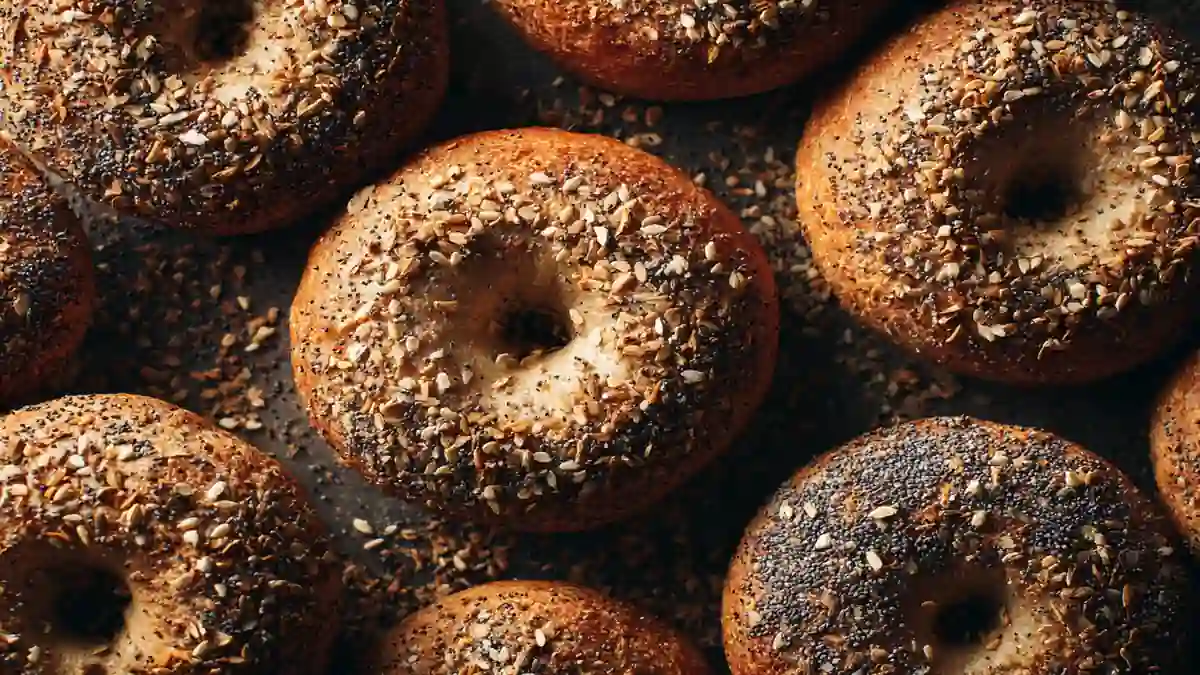These multigrain bagels pack 4 whole grains, oats, flaxseed, wheat germ, and whole wheat, for a chewy, filling bite with real texture. Bake them in under 30 minutes for better flavor than store-bought.
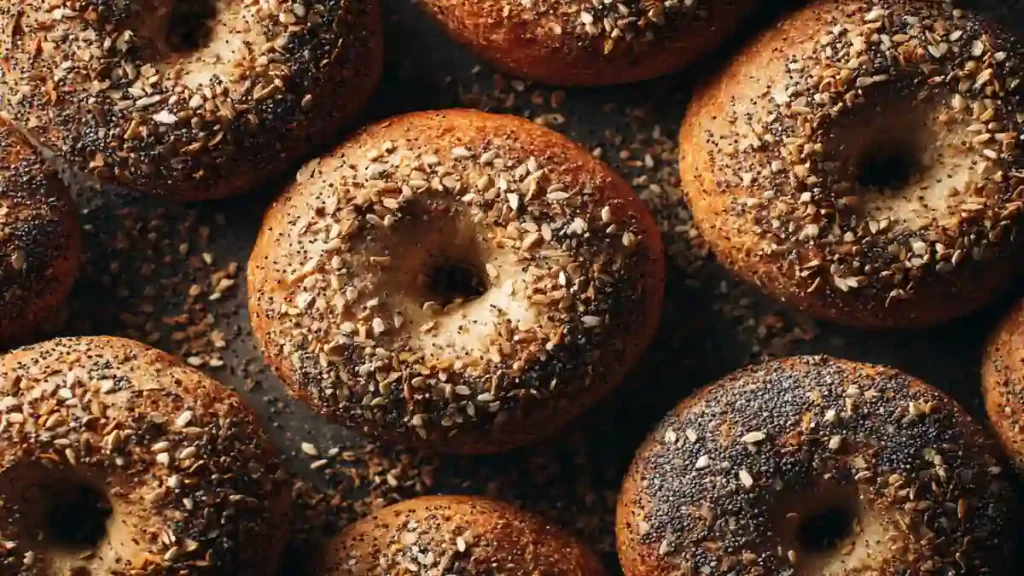
The first time I made these multigrain bagels, I wasn’t trying to outdo the bakery, I just wanted something homemade, hearty, and a little bit special for Sunday morning. What I didn’t expect was how good they’d be: chewy, golden, and filled with the kind of flavor store-bought bagels only pretend to have. Now they’re a weekend staple in our house, and I promise they’ll become one in yours too. No fancy ingredients, no stress, just a warm kitchen and the smell of something real baking in the oven.
Table of Contents
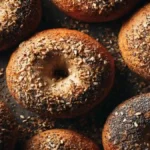
Healthy Multigrain Bagel Recipe You’ll Love. Powerful & Easy
- Total Time: 120 min
- Yield: 290mg 1x
Description
Soft, chewy multigrain bagels with a golden crust—made from scratch with wholesome ingredients. This foolproof recipe makes bakery-quality bagels right at home, perfect for weekend brunch or meal prep.
Ingredients
2¼ tsp active dry yeast
1½ cups warm water (110°F)
2 tbsp brown sugar
1½ tsp salt
1½ cups bread flour
1½ cups whole wheat flour
½ cup rolled oats
¼ cup ground flaxseeds
2 tbsp sunflower seeds
1 tbsp olive oil
Instructions
In a small bowl, combine warm water and yeast. Let sit for 5–10 minutes until foamy.
In a large mixing bowl, whisk together flours, oats, flaxseeds, sunflower seeds, salt, and brown sugar.
Add the yeast mixture and olive oil to the dry ingredients. Mix and knead until smooth and elastic (8–10 minutes).
Cover the dough and let it rise in a warm spot for about 1 hour or until doubled in size.
Divide dough into 8 equal pieces. Roll each into a ball, then poke a hole in the center and stretch to form a ring.
Let shaped bagels rest for 10 minutes. Meanwhile, preheat oven to 425°F and bring a large pot of water to boil.
Boil each bagel for 1–2 minutes per side. Drain and place on a parchment-lined baking sheet.
Bake for 20–22 minutes or until golden brown and firm. Cool on a wire rack.
Notes
Top with oats, sesame, or everything seasoning before baking.
Freeze sliced bagels for easy weekday toasting.
Swap sunflower seeds for pumpkin seeds or hemp hearts.
- Prep Time: 20 min
- Rising + Boiling: 100 min
- Cook Time: 20 min
- Category: Protein Bagels, Bread, Breakfast, Baking
- Cuisine: American
Nutrition
- Serving Size: 8 bagels
- Calories: 220
- Sugar: 3g
- Sodium: 290mg
- Fat: 5g
- Saturated Fat: 0.5mg
- Carbohydrates: 40g
- Fiber: 4g
- Protein: 8g
- Cholesterol: 0mg
What Makes a Bagel “Multigrain”?
Multigrain vs. Whole Grain. Wait, What’s the Difference?
Here’s the scoop: multigrain means it’s made with more than one grain (obviously), but that doesn’t always mean they’re whole grains. Whole grains include all parts of the seed, bran, germ, and endosperm, which is where the fiber and nutrition live.
This recipe’s loaded with real-deal grains, whole wheat flour, oats, flaxseed, and wheat germ, all ingredients that bring flavor, fiber, and that hearty chew. That’s what gives our bagels their deep, nutty flavor and that satisfying chew that keeps you full way longer than your average white flour bagel.
Why You’ll Love Multigrain
Once you taste a fresh, homemade multigrain bagel, store-bought won’t cut it. These guys:
- Stay chewy inside, crusty outside
- Have a nuttier, fuller flavor
- Pair beautifully with both sweet and savory toppings
- Are loaded with fiber and plant-based protein
They fit right in on our weekend breakfast table, usually sharing the spotlight with some fresh-milled muffins, juicy fruit, and the kind of chatter that makes you forget the coffee’s gone cold.
Ingredients for Chewy Multigrain Bagels
What You’ll Need (Yields 16 Bagels)
| Ingredient | Amount |
| Warm water (105°F) | ½ cup |
| Active dry yeast | 2 packets (.25 oz each) |
| White sugar | ½ tsp |
| Whole wheat flour | 4 cups |
| Bread flour | 2 cups |
| Rolled oats | 1 cup |
| Vital wheat gluten | ¼ cup |
| Wheat germ | ¼ cup |
| Organic flaxseed meal | ¼ cup |
| Sea salt | 1 tbsp |
| Buttermilk | 3 cups |
| Orange blossom honey | ⅓ cup |
| Cooking spray | As needed |
| Water (for boiling) | 3 quarts |
| Brown sugar | 1½ tbsp |
| Cornmeal (for trays) | 1 tbsp or as needed |
| Egg white | 1 |
| Cool water (for egg wash) | 1 tsp |
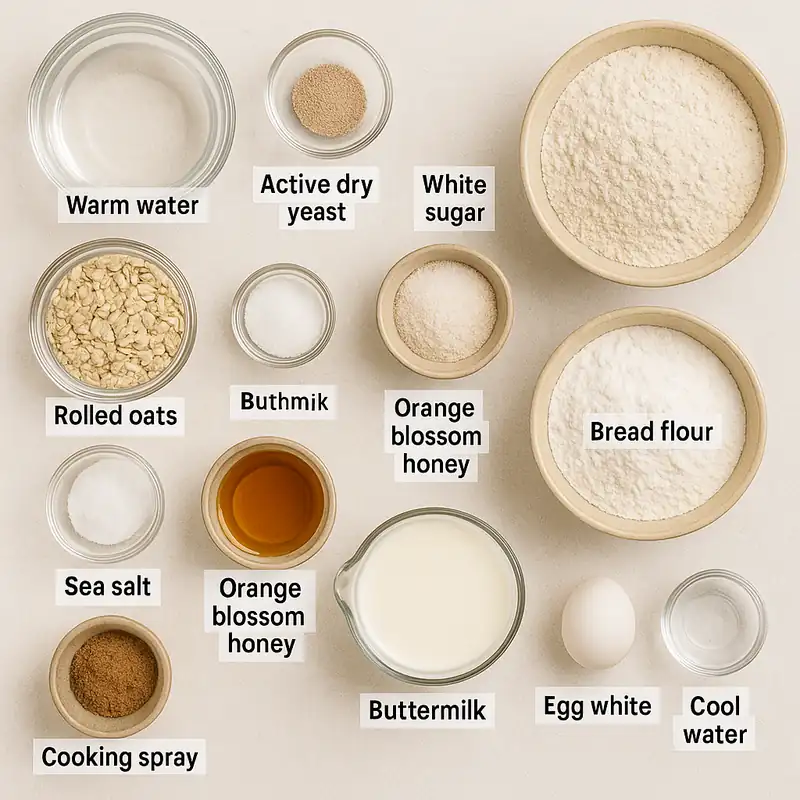
This recipe’s flavor depth is similar to our high-protein lineup, but the texture’s got extra oomph thanks to the grains.
How to Make Multigrain Bagels from Scratch
Step-by-Step Bagel Bliss
You’ll Need:
- 4 large baking sheets
- Mixing bowls
- Large pot for boiling
- Pastry brush
- Clean towel, wax paper, parchment paper, and cornmeal
1. Activate the Yeast
In a small bowl, mix:
- ½ cup warm water (around 105°F – think warm bath, not hot tub)
- 2 (.25 oz) packets of active dry yeast
- ½ teaspoon white sugar
Let it sit for 5 minutes, untouched.
You’re looking for a bubbly foam on top, if it doesn’t foam, toss it and start over (it’s like your dough’s battery won’t charge). This is the step that gives your bagels their chew and rise.
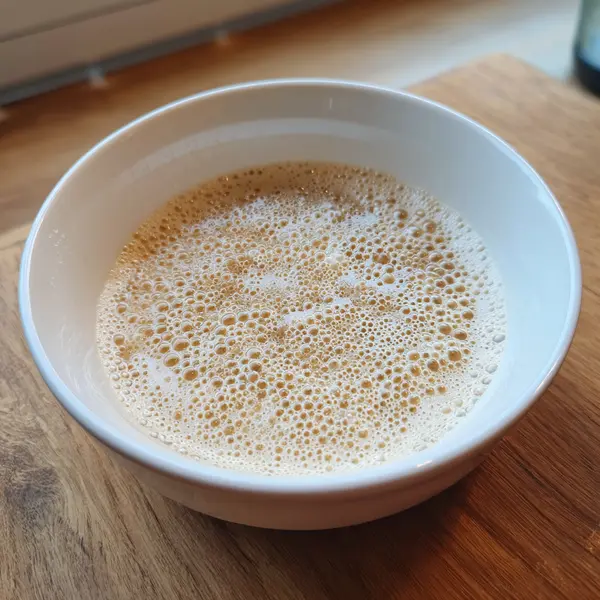
2. Make the Dough
In a very large mixing bowl, stir together:
- 4 cups whole wheat flour
- 2 cups bread flour
- 1 cup rolled oats
- ¼ cup vital wheat gluten
- ¼ cup wheat germ
- ¼ cup organic flaxseed meal
- 1 tablespoon sea salt
Now pour in:
- 3 cups buttermilk
- The yeast mixture you just activated
- ⅓ cup orange blossom honey (or your fave local kind)
Use a wooden spoon or silicone spatula to mix it all until there are no dry patches of flour left. The dough will be dense, sticky, and shaggy, like muffin batter that decided to hit the gym. Let it sit for around 20 minutes, covered loosely with plastic wrap.
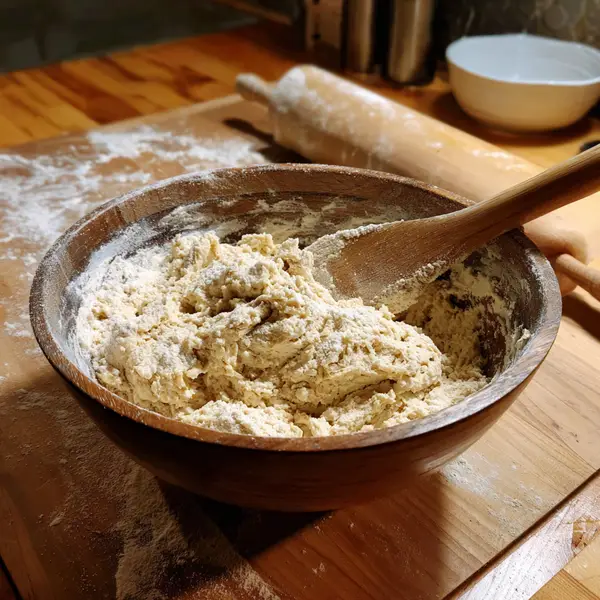
3. Knead & First Rise
Sprinkle a little flour on the counter, then flip the dough out like you mean it. Knead by hand for 7 full minutes, press, fold, push, rotate, until the dough is smooth and slightly tacky but not messy.
Pro Tip: If it sticks like crazy, sprinkle in a spoonful of flour at a time, but don’t go overboard, you want a soft, elastic dough.
Spray a clean bowl with cooking spray. Drop the dough in, flip it once to coat, then cover tightly with plastic wrap. Let it rise in a warm, draft-free spot (like inside your turned-off oven) for 2 hours, or until doubled in size.
It should feel airy but still firm, like the dough you use in our protein bagels, but with extra fiber and heft.
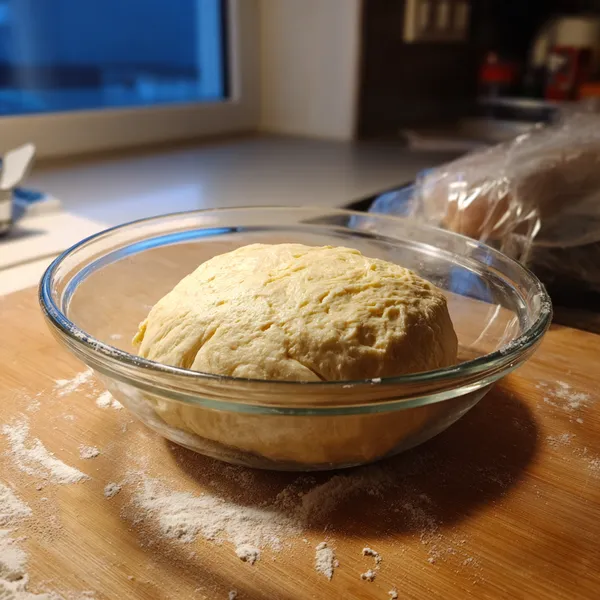
4. Shape the Bagels
Turn the dough onto a lightly floured surface. Knead gently for 30 seconds to deflate. Cut the dough in half. Then:
- Roll each half into a long log
- Cut each log into 8 equal pieces
- You’ll have 16 dough balls
Give those bagels a little spa moment, dab the tops with egg wash using your trusty pastry brush. Gently stretch the hole to about 1¾ inches wide.
Repeat with all pieces. Place shaped bagels on a wax-paper lined tray, cover with a towel, and let rest while you prep your boiling setup.
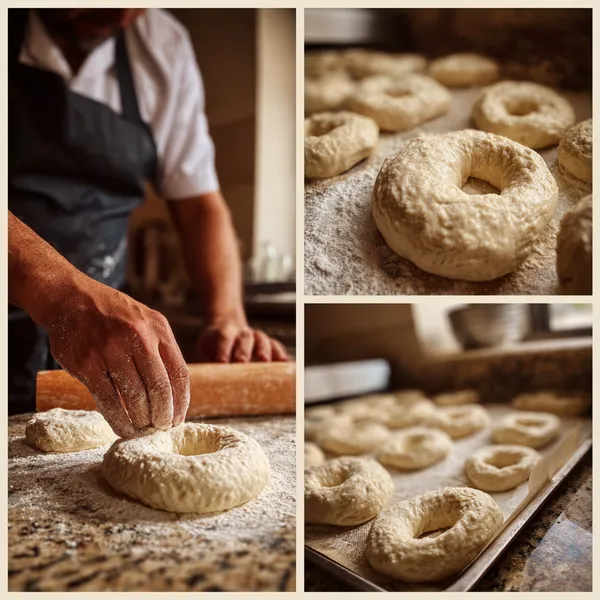
5. Boil for That Signature Chew
Preheat oven to 400°F.
Set up:
- 1 tray with wax paper
- 1 with a clean towel
- 2 trays lined with parchment paper, sprinkled with cornmeal
In a large pot, bring to a boil:
- 3 quarts water
- 1½ tablespoons brown sugar
Once boiling, reduce to a gentle simmer.
Using a slotted spoon or your hands (carefully!), drop in 2 bagels at a time. Boil for 30 seconds per side. They’ll puff up slightly, that’s perfect.
Transfer first to towel-lined tray to drain briefly, then onto cornmeal trays.
This step gives you that shiny, chewy crust, just like the best bakery bagels.
6. Egg Wash & Bake
Whisk together:
- 1 egg white
- 1 teaspoon cool water
Brush the tops of each bagel with the egg wash using a pastry brush.
Bake for 12 minutes, then flip each one with a spatula or tongs. Return to the oven for another 13 minutes, until the bottoms are golden and the tops look deep brown and glossy.
Cool on a wire rack for at least 10–15 minutes, if you can wait.
Nutrition Facts + Healthier Bagel Tips
Nutrition Breakdown (Per Bagel)
Here’s what you’re working with for one of these bakery-style multigrain bagels (based on the tested 16-serving recipe):
| Nutrient | Amount |
| Calories | 258 |
| Fat | 3g |
| Carbohydrates | 50g |
| Protein | 11g |
| Fiber | ~4–6g (estimated) |
| Sugars | ~5g |
| Sodium | Moderate (from salt + buttermilk) |
📌 These values can vary slightly based on toppings and flour brands, but overall, these bagels bring solid fiber and protein without being calorie bombs.
Are Multigrain Bagels Actually Healthier?
Short answer: Yes, if made right.
Not all multigrain bagels are created equal. Some are just white flour with a few oats slapped on top. But this recipe is made with:
- 100% whole wheat flour base
- Flaxseed, wheat germ, oats, all fiber-rich whole grains
- Honey instead of refined sugar
- Buttermilk for a soft texture and added calcium
If you’re looking for a morning bite that keeps you full and supports digestion, these beat plain bagels or store-bought imposters by a mile.
They’re the perfect swap if you’re used to grabbing a bagel and coffee on the run, but want something that won’t leave you crashing by 10 a.m. (Try pairing one with a blueberry protein muffin on Sunday and have grab-and-go breakfasts all week.)
Smart Toppings for Multigrain Bagels
Some combos we love:
- Savory: Veggie cream cheese, avocado + tomato, or sharp cheddar + scrambled eggs
- Sweet: Almond butter + banana, ricotta + figs, a cinnamon-raisin mash-up (yep, we turn leftovers into spreads around here).
For high-protein toppings, try cottage cheese, smoked salmon, or a soft-boiled egg sliced thin. These all bring balance to the bagel’s carb-rich base.
You can also slice and toast the bagel, then top it like a mini open-faced sandwich, we do this with leftovers when we’ve got protein muffin crumbs on the counter and want a power snack.
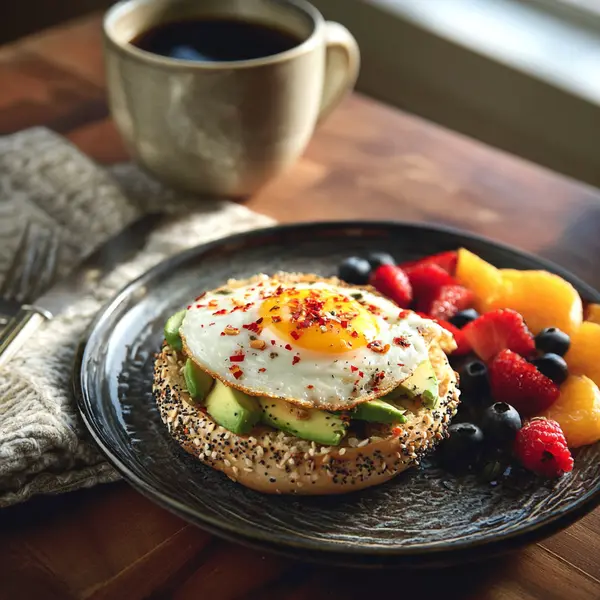
Betty’s Bagel Tips (aka What I Messed Up So You Don’t Have To)
- Don’t over-knead, 7 minutes is your sweet spot. More = dense.
- If your bagels deflate in the boil, your rise may have gone too long.
- That hole in the middle? Stretch it bigger than you think. It’ll shrink during boiling + baking.
- Use a damp towel while shaping to keep them from drying out.
Mia once made a batch where the holes sealed shut completely. Jordan called them “pillow breads.” Still tasty. Still got eaten.
Multigrain Bagel FAQ
Are multigrain bagels healthier?
Yes, especially when made with whole grains like flaxseed, oats, and wheat germ. These provide fiber, protein, and slower-digesting carbs. For more on benefits and what to avoid in store-bought ones, check our bagel nutrition guide
What exactly makes a bagel multigrain?
A multigrain bagel contains two or more different grains—like wheat, rye, oats, or flax. Not all are whole grains, though. Harvard Health breaks down grain types and how they affect nutrition and digestion.
What is the healthiest flour to use for bagels?
Whole wheat flour is the most nutritious and high in fiber. Bread flour adds structure. We use both in this cottage cheese recipe for a chewy, protein-rich base that holds up perfectly.
What toppings taste best on a multigrain bagel?
Try savory combos like herbed cream cheese, smoked salmon, or avocado. Sweet spreads like nut butter or jam also shine. Get creative with these options from our full topping ideas article
Can I freeze homemade multigrain bagels?
Yes, slice them first and wrap tightly. Freeze for up to two months. Reheat in a toaster or oven. USDA offers food-freezing tips to help baked goods stay safe and fresh longer.
Are store-bought multigrain bagels good for you?
Sometimes, but many use enriched flour with only a few seeds. Look for “whole grain” first on the label, or bake your own like our naturally sweet cinnamon version for better control and nutrition.

